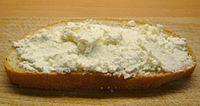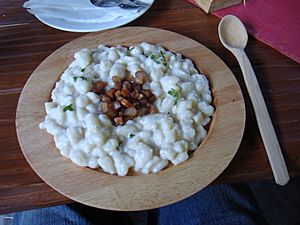Bryndza facts for kids
Quick facts for kids Bryndza |
|
|---|---|
 |
|
| Country of origin | Lua error in Module:Wikidata at line 70: attempt to index field 'wikibase' (a nil value). |
| Region | Central and Eastern Europe |
| Source of milk | Sheep, goat, cow |
| Pasteurised | No |
| Texture | Depends on variety |
| Fat content | Depends on variety |
| Certification | Bryndza Podhalańska: PDO Slovenská bryndza: PGI |
| Named after | Lua error in Module:Wikidata at line 70: attempt to index field 'wikibase' (a nil value). |
Bryndza is a special kind of cheese made from sheep milk. Its name comes from the Romanian word brânză, which simply means "cheese". This creamy white cheese is popular in countries like Slovakia, Ukraine, Romania, and southern Poland. These places are mostly found around the Carpathian Mountains.
Bryndza is known for its strong smell and taste. It is white, tangy, and a bit crumbly and moist. The flavor starts out mild, then gets stronger, and finishes with a salty taste. Different countries might have slightly different ways of making it.

Contents
What is Bryndza?
Bryndza is a soft, spreadable cheese. It is usually made from sheep's milk, but sometimes it can also include goat or cow's milk. The cheese gets its unique strong flavor from the way it is made. It's often used in cooking, especially in traditional dishes.
Where Does the Name Come From?
The word Bryndza comes from the Romanian word brânză. In Romanian, this word just means "cheese" in general. The name spread to other European countries because of traveling shepherds called Vlachs. They helped share this type of cheese and its name.
You might hear Bryndza called by other names too. For example, in Hungary, it's called juhtúró. In Germany, it's known as Brimsen.
The History of Bryndza Cheese
The first time the word Bryndza was written down was in 1370. It was described as "Vlach cheese" in a Croatian port city called Dubrovnik. Later, it was recorded in Hungary in 1470 and in Poland in 1527.
In Slovakia, Bryndza is a very important part of their food culture. Many people think of it as a truly Slovak product. The modern, soft version of Bryndza that you can spread was likely created in the late 1700s. This happened in a town called Stará Turá in Western Slovakia.
People from Stará Turá started making Bryndza in factories. These factories were in the mountains of Central and Northern Slovakia. This area already had a long history of making sheep cheese. They sold Bryndza all over the Austrian Habsburg monarchy. In Austria, it was sometimes called Liptauer, named after the Liptov region in northern Slovakia.
Special Recognition for Bryndza
Some types of Bryndza have special protection in the European Union. This means they can only be called by certain names if they come from a specific place and are made in a certain way.
- Slovak Bryndza: This cheese from Slovakia was officially recognized in 2008. It has a "Protected Geographical Indication" (PGI). This means that to be called "Slovak Bryndza," it must contain at least 50% sheep milk. If it's called Sheep (ovčia) bryndza, it must be 100% sheep cheese.
- Bryndza Podhalańska: This type of Bryndza from Poland was recognized in 2007. It has a "Protected Designation of Origin" (PDO). This means it must come from the Podhale region of Poland and follow specific rules for how it's made.
Images for kids
See also
 In Spanish: Bryndza para niños
In Spanish: Bryndza para niños


